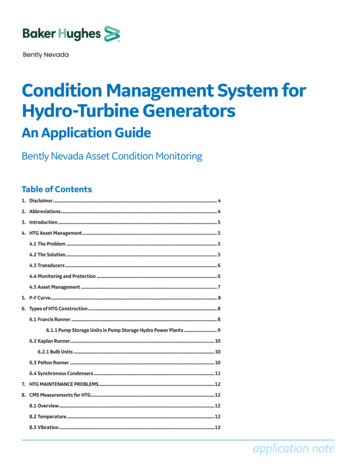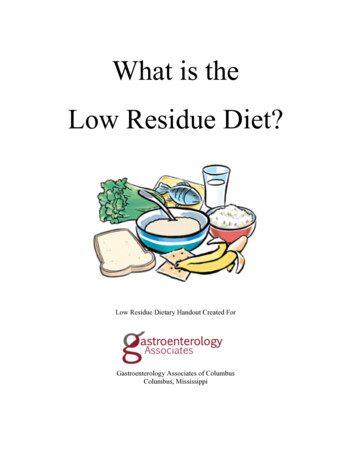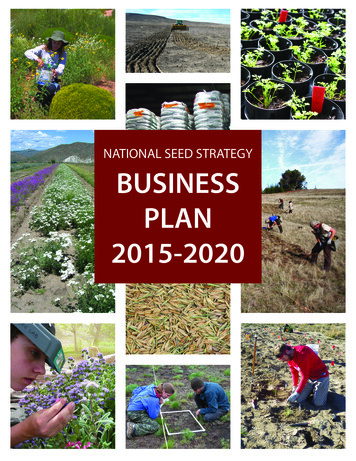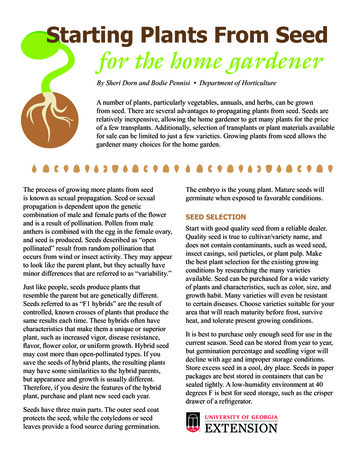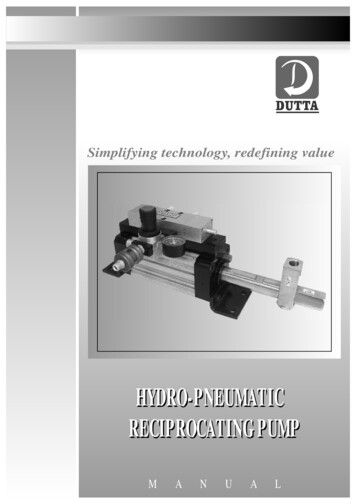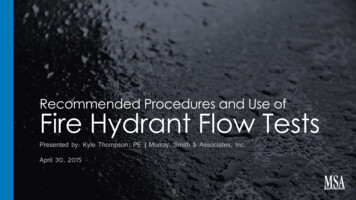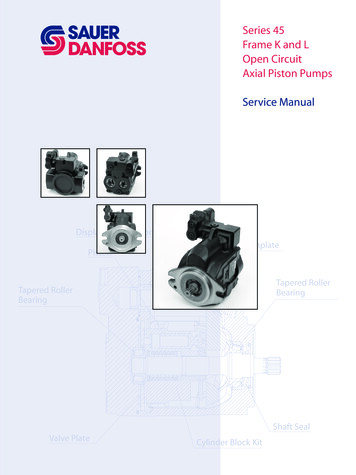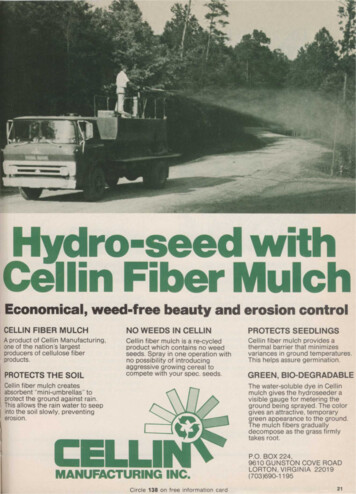
Transcription
Hydro-seed withCellin Fiber MulchEconomical, weed-free beauty and erosion controlCELLIN FIBER MULCHNO WEEDS IN CELLINA product of Cellin Manufacturing,one of the nation s largestproducers of cellulose fiberproducts.PROTECTS SEEDLINGSCellin fiber mulch is a re-cycledproduct which contains no weedseeds. Spray in one operation withno possibility of introducingaggressive growing cereal tocompete with your spec, seeds.Cellin fiber mulch provides athermal barrier that minimizesvariances in ground temperatures.This helps assure germination.PROTECTS THE SOILCellin fiber mulch createsabsorbent "mini-umbrellas" toprotect the ground against rain.This allows the rain water to seepinto the soil slowly, preventingerosion.tf j lpiP L t PJfeb z&m&tex*JCELLHMANUFACTURING INC.GREEN, BIO-DEGRADABLEThe water-soluble dye in Cellinmulch gives the hydroseeder avisible gauge for metering theground being sprayed. The colorgives an attractive, temporarygreen appearance to the ground.The mulch fibers graduallydecompose as the grass firmlytakes root.P.O. BOX 224,9610 GUNSTON COVE ROADLORTON, VIRGINIA 22019(703)690-1195
The 2-Step TUrf Renewal Planwith Roundup and Pennfine.One. Two.Spray Roundup on theturf area to be renewed.With just one application ofRoundup herbicide by Monsanto, youcan control or destroy most unwantedvegetation. Including stubborn intruderslike annual bluegrass, bermudagrass,quackgrass, johnsongrass, tall fescue, andkikuyu grass.In a matter of days, Roundupcirculates throughout these weeds. Eveninto the below-ground roots, destroyingthe entire plant. Yet Roundup hasno residual soil activity. That meansthere is no injury to new seedingsplanted after application.ALWAYS READ AND FOLLOW THE LABEL FOR ROUNDUP. ROUNDUP IS A REGISTERED TRADEMARK OF MONSANTO CO.ST. LOUIS. MOMONSANTO COMPANY 1979Spread Pennfine PerennialRyegrass seed over the area treatedwith Roundup.After applying Roundup, seedwith fast-growing, fine-leafed PennfinePerennial Ryegrass. Pennfine wasdeveloped by Dr. Joe Duich at Pennsylvania State University. Pennfine hasbeen proven to germinate quicker, growdenser, and resist disease better thantraditional ryegrasses. And it penetratescompact soil, sending its roots todeptns of 12 to 18 inches. Thesequalities make Pennfine an excellentchoice for turf renewal and help toexplain why it's used by turf professionals from coast to coast. In a shorttime, you'll see the proof for yourself.PENNFINE PERENNIAL RYEGRASS HAS BEEN ACCORDED U.S. PLANTVARIETY PROTECTION CERTIFICATE NO. 7200019.
Freer*It will have cost younothing to see how dramaticallythe 2-Step I\irf Renewal Plancan improve your turf.Our free kit contains enoughRoundup and Pennfine to renew about200 square feet of turf. And whenyou see the results, you can judgefor yourself just how well thisnew concept in turf renewalworks. Roundup and Pennfine- t h e 2-Step TurfRenewal Plan.Put Our Free Kit to the Test.Find out for yourself howeffectively these two superior productswork together in a simple turf renewalprogram. All it will cost you is the priceof a stamp.Name(Please print)Company or InstitutionAddressStateZipSend this coupon to:Turf Renewal Plan,Box 923, Minneapolis,MN 5 5 4 4 0Note: this offer is restrictedto turf professionals—thosewhose livelihood depends onthe maintenance of quality turf.Limit one per companyorcourse. Offer void whereprohibited by law.
Out of Season Diggingfrom page 20plant. They are most known for their use inpreventing winter injury, but they have successfully been used during transplanting. Someg r o w e r s i n d i c a t e d that they a p p l i e d antitranspirants just prior to digging, while otherpreferred to make their applications just afterremoval. Some even indicated that if the materialwas properly cared for, root pruning, misting, etc.,that anti-transpirants were not necessary at all.The summer is a very touchy time to move plantmaterials, especially for long distances. On hotsunny days, it is best to wait until late afternoon orearly evening before loading trucks so that they cantravel during the night when the temperatures arecool. Depending on the distance, the materials willstill arrive in fairly good condition the followingmorning. It is, of course, unrealistic to expect allshipping to be done overnight, but it helps preservethe plants. In the case of tall trees which will not fitinto enclosed trucks, open trucks must be used andthe materials covered to prevent further waterlosses. Whenever possible, refrigerated trailers areused for materials that are transported long distances.Water is the most critical factor in maintainingplant materials in the retail yard or Garden Center.If the plants are constantly allowed to dry out, theirchances of survival are greatly reduced.As for planting, it is wise to plant the same dayor as close to the day of purchase as possible. Thismeans knowing exactly where you or yourcustomer want the trees or shrubs. Unfortunately,most homeowners are unknowledgeable when itcomes to caring for nursery stock before it isplanted. It has been my experience as an extensionhorticulturist that the homeowner feels it's okay tosprinkle them lightly with the hose whenever theythink of it and that will suffice until they getaround to planting them. They can get by with thisin the spring or the fall, perhaps, but not in thesummer.Soil type and drainage are important factors inthe survival of plant materials. Generally a porussoil is better than one with a high clay content,which tends to hold excessive amounts of water. Ifthe soil has a lot of clay, a raised bed can be used toget around this problem. A raised bed consists ofraising the area twelve to fifteen inches with aporus soil mixed with peat moss and surroundingthe area with blocks or railroad ties to keep the soilfrom drifting. This method of raising the soil levelshould never be used if there are existing plantmaterials already in the bed.Another way of dealing with wet soils is to planttrees and/or shrubs which will grow in moist soilconditions. Your Cooperative Extension Agent canhelp in providing a list of such materials for yourarea.Fertilizer can be added to the planting hole atthe rate of two cupfuls per three foot of holediameter. A complete fertilizer, higher in phosphate than the other two nutrients, should be used.These trees won't need to be fertilized again untilnext spring.If the soil is well-drained, then dig a hole abouttwice the width and depth of the root ball. Thenback fill with six inches of good top soil and placethe rootball. Then backfill the hole with a mixtureof one part peat to two parts of good top soil untilthe hole is the same depth as the root ball.The top of the ball must be level with theground. Remember to remove the rope or lace andpull down the burlap. If the burlap is not biodegradable remove it. Anything that will notdegrade will hinder the plant's growth.The hole can then be filled three-quarters fulland tamped well, being careful not to damage theestablished soil ball. Then water and finish fillingthe hole, leaving a saucer type depression aroundthe base of the tree or shrub. This will help to confine the water to the area around the root ball.During the summer it is extremely important towater each plant immediately after planting. It isdifficult to do when an entire area is being planted,but the extra effort will pay. off in the long run.Aftercare is extremely important and the homeowner should be made aware of that. Newplantings should be thoroughly watered at leasttwice a week. For this can make the difference as tohow well the material comes through the summer,or if it comes through at all.Guying is usually recommended for newlyplanted trees to give them support and to preventdamage from heavy winds. Guy wires are attachedto the tree and staked to the ground in three places.A plastic or rubber hose is used as a cushion between the wire and the trunk of the tree. They areplaced in the area of the lower branches. This support should be taken off after one to two years afterplanting. By that time, the tree will be able to support itself. If guy wires are left on, they can girdlethe trunk and eventually kill or weaken the tree sothat it could easily break over during a storm.Young trees — especially ones with thin bark,such as dogwoods, beeches and maples, andwhose bark is susceptible to drying out or sunscaldshould be wrapped. Wrap them from the base ofthe tree to just below the lower branches. The wrapcan be left on for one to three years.Mulching can be a real asset to summer plantingsince the purpose of mulches are twofold: to conserve soil moisture and to prevent weeds fromcompeting with plant materials for water supplies.Some good mulches are: wood chips, choppedbark, pine needles, small stones, peanut or cocoahulls, black polyethylene or even sawdust.All transplanted materials should be observedcarefully, especially the first year. Make absolutely sure that they are watered well. If thewater is neglected, the entire effort will bewasted.WTT
big in displacement!bigger in performance!biggest in acceptance!Synchro-BalanceRsubstantially reduces vibration.Longer lasting p o w e r t h r o u g h h e a v y d u t y a l u m i n u m a l l o yconstruction.Quick, quiet starts in all climates from 12-volt electricBriggs & Stratton 11 hp. engines are the most popularstarter. B a t t e r y charges even w h e n e n g i n e idles andlawn and garden tractor engines in use anywhere andlights are on.here's why:Q U A L I T Y A S S U R A N C E . UncompromisingP O W E R . Full rated power at 24.36 cu. inquality control of all materials, manu(339.2 cc.) displacement. Peak torquefacturing, and f i n a l a s s e m b l y . Briggs& S t r a t t o n m a k e s all m a j o r e n g i n eof 17.8 ft. lbs. at 2800 RPM. Efficient atcomponents.low speeds for quietness and safety.S E R V I C E E V E R Y W H E R E . 25,000P E R F O R M A N C E . Stellite exhaust valveAuthorizedand seat and exhaust valve rotator proService Centersvide over four times the life of stanw o r l d w i d e withdard valves.factory-trainedThe quality-assurance trademarkSynchro-Balance minimizes vibrapersonnelpeoplelookfortion for more operator comfort andstocking originallonger engine and e q u i p m e n t life.Briggs & Stratton Corporationfactory parts.Milwaukee. Wisconsin 53201
NEED FOR GROWTH REGULATORSACCENTUATED BY RISING COSTSR. P. Freeborg, Purdue University, West Lafayette, IndianaT h e concept of controlling plant growth withnatural plant substances, such as auxins, was firstdeveloped in 1926-28 when F. W. Went identifiedand measured plant growth differences resultingfrom the application of very minute quantities ofthese natural plant hormones.Auxins, as natural plant hormones, were thusable to stimulate plant growth. Eventually purelysynthetic compounds were artificially made thatcould simulate their actions.From this discovery followed the identificationof natural organic substances in plants that couldeither inhibit or suppress various growth functionsin plants. Some of these naturally occurring inhibitory functions we are familiar with include:1. The maintenance of a dormant state in seedsof many plants until acceptable environmentalconditions favorable for growth development.2. Prevention of premature germination beforeadequate seed dispersal is attained.3. Spreading germination over a long period,amounting to years in some cases, to assure thecontinuity of a species.4. T h e ability of plants to compete in a mixedstand is also attributed, in some instances, to therelease of an inhibitor by the plant that can prevent the development of other potentially competitive species. One. example is that of a wheatrye stand able to suppress growth of several competitive weeds.The concept of chemically controlled growth inhibition for specific purposes developed. Initiallythis b e c a m e most important as in the developmentof herbicides for the selective control of undesirable weed species. One of the earliest andmost successful of these was the family of phenoxyherbicides of which 2.4-D was the most important.Since this discovery there has b e e n a rapid increase in the introduction and use of plant growthregulators in agriculture, on recreational sites, andin horticulture. T h e many selective preemergentherbicides are an excellent example of growth inhibitors selectively controlling undesired species.It is only recently that the concept of growthstimulation to increase crop yields in agricultureand growth regulation or growth suppression inhorticultural and turf maintenance have b e e nsuccessfully applied on a large scale.Increased yields in agriculture are now obtained with the application of synthetic plant hormones that can increase corn production, sugarcontent in sugar cane, and pineapple yields. It hasbeen stated that the next major breakthrough infood production world wide will be through theuse of plant growth regulators. T h e potential isthere and only limited by the imagination.Since we are now going to discuss growthregulators and their present day application inplant growth, the term should be defined. A growthregulator is a substance used for controlling ormodifying plant growth processes without appreciable phytotoxic effect at the dosage applied.In horticulture we now see the use of growthregulators to control height, as a substitution forcold treatment, for chemical disbudding, to hastenflowering, to produce longer lasting flowers, andfor defoliation. (See "Growth Regulators Effectiveon Floricultural Crops" by R. D. Heins, R. E. Widmer, and H. F. Wilkins, Dept. of HorticulturalS c i e n c e and Landscape Architecture, University ofMinnesota, St. Paul, MN for a complete list of compounds and uses). Fruit production is also enhanced by artificial thinning with these compounds.Uniformity of ripening in tomatoes with the use ofethylene has also b e e n successful. T h e r e are manyother examples to demonstrate the usefulness ofthese compounds. T h e s e early success stories areimpressive, yet the industry is only in the earlystages of development.T h e controlled growth of turfgrass species alsodemonstrates the practicality of this controlledgrowth concept. Today with high labor costs andfuel shortages, and the continued increase in fuelcosts, the need for effective growth regulators isaccentuated. A recent example, for the first time in1979 the Indiana State Highway Department used agrowth regulator when there were no acceptablemowing contracts submitted. In turf growth control, as in other fields, there remains a great potential and need for more effective compounds.One of the first plant growth regulators sold inthe United States was maleic hydrazide (M.H.) introduced in 1950. By 1965 more than three millionpounds of growth regulators were sold in the U.S.Height of unmowed Merion bluegrass next to treatedbluegrass four weeks after application.
M.H. accounted for approximately 90%. By 1972the quantity used increased to six million pounds,with M.H. comprising 70%. By 1975, newer growthregulators were estimated to have accounted formore than 50% of the total market.There are two primary methods by whichgrowth regulators control plant growth functions.1. Terminal growth inhibition. Some of the effective growth inhibitors now available, including maleic hydrazide, the flurenols, andethylene releasing compounds act by inhibitingterminal bud growth. These growth inhibitingcompounds usually alter geotropic responses,cause axillary bud break or induce early leafloss, and reduce stem elongation in some plants.Inhibitors such as M.H., the flurenols, andethylene, that disturb terminal bud growth activity cannot, generally, be used where normalleaf and flower initiation and development arenecessary.2. Internode elongation inhibition. These arecompounds which inhibit internode elongationwithout disrupting terminal bud development.Retardants such as CCC (Cycocel ), ancymidol(A-Rest ), etc. are usually recommended toreduce plant height in potted plants, nurserycrops and fruit trees since leaf and flower initiation are not severely delayed.Some of the existing growth regulatory compounds would include:1. Ancymidol (A-Rest )2. CBBP (Phosphon-D )3. CCC (Cycocel )4. C h l o r f l u r e n o l ( M a i n t a i n CF125 ), (PoSan )5. Mefluidide (Embark )6. Ethephon (Ethrel ), (Cepha ), (Florel )7. Maleic hydrazide (Slo-Gro ), (Royal SloGro )8. Daminozide (Alar-87 ), (B-Nine SP )9. Gibberellic acids (GA 3 , GB 4 , 6A7)The choice of inhibitor will depend on the objective. In turf the selection of a compound to control plant height often depends to a great extent onthe degree of plant discoloration on thinning thatcan be tolerated and whether only seedheadprevention is desired. The M.H., flurenols,mefluidide (Embark ) and ethephon can all control excessive plant height. There are situations,h o w e v e r , w h e r e high t e m p e r a t u r e s , e x c e s sdrought, insect or disease activity can cause turfthinning and discoloration since the turf is unableto recover rapidly due to the growth regulator activity. There are sites where these conditions canbe tolerated and where these compounds have avery important place. This would be true for plantsviewed from some distance, such as from movingvehicles. Thus the phytotoxic side effects of somecompounds can be tolerated.M.H., the flurenols, and now Embark havesuccessfully reduced the need for mowing grassyareas in the United States and Europe. Reducedblade and sheath elongation are beneficial effects.The reduced length of the seed stalk and reductionof seedhead formation are major factors in the useof these products for roadside maintenance.For most lawn turf, inhibition of the plant stemand leaf blade elongation is all that is desired.Complete prolonged inhibition of new leafformation, tillering, rhizome, and root formation isundesirable and will eventually lead to a reductionin turf density as the existing plant parts die andthere is not adequate regrowth for recovery.The M.H., flurenols and Embark, though effective growth regulators, cause a general reductionin quality of good turfs of Kentucky bluegrass,bentgrass, and bermudagrass. This reduction inquality is especially severe under either pest or environmental stress.Maleic hydrazide at 4 lbs. ai/A restricts stemand leaf growth and inhibits seedhead development. It is best on minimum use turfgrass sites suchas roadsides, steep slopes, pond or stream banks,along fence rows and around trees where trimmingcosts are excessive. Root and rhizome growth maybe restricted. Repeat applications, without a turfrecovery period, can result in additional thinning.Flurenols used at 1-3 lbs. ai/A give good shootgrowth retardation as well as inhibition of apicalbud formation. Leaf color is enhanced. They aremost effective when used in combination with themaleic hydrazide.Embark 2-S at 0.12 to 1 lb. ai/A on cool seasongrasses and 0.5 lb. to 1 lb. ai/A on the warm seasongrasses offers good turfgrass growth inhibition andsuppression of seedheads. The leaf has a darkergreen color than that of untreated grasses. There isalso some evidence of root growth stimulation. Ithas some herbicidal activity and therefore can betoxic if rates are not carefully controlled. The compound successfully inhibits fine turf, but hereagain, under environmental and/or pest incidencestress thinning results.Another growth regulator that has some potential for the turf market is ethephon. When used at4-6 lbs. ai/A moderate to good growth inhibition ofperennial bluegrass is observed. Green leaf coloris enhanced. There is also some evidence of tillerstimulation although with some inhibition ofrhizome development. There is an increase in leafnumbers per plant. The leaves are shortened withslightly elongated internodes. This tends to dwarfthe plant and thus results in the necessary growthreduction. Therefore, the plant, although dwarfed,continues to grow and offers some protection fromenvironmental stress and pest damage.The efficacy of these growth regulators can beseen in the data from Purdue 1976 presented inTable 1.The potential of some existing experimentalgrowth r e g u l a t o r s is e n c o u r a g i n g . Growthregulators are able to change the bluegrass plantform by shortening the leaf and lengthen the internode, to stimulate rhizome bud formation onperennial bluegrass, and to e n h a n c e d tillerformation as rates increase.The ideal turfgrass growth regulator is one thatwill reduce leaf and stem height and producemany small leaves to maintain surface density andContinueson page30
U.S. Plant Patent 3151KENTUCKYBLUEGRASSDouble-duty turf beauty.The natural choice.The elite bluegrass growing in the sun is Glade. The elitebluegrass growing in the shade is Glade. That makes it thenatural choice for all lawns. It performs well in up to 60%shade with a higher resistance to powdery mildew. Additionally, Glade has better-than-average resistance to Fusarium blight It's now used as a prime ingredient for fortification in many professional turf grass mixes. A Rutgersselection, Glade has outstanding medium to deep greencolor. Low-growing Glade germinates and establishes fast,developing a thick rhizome and root system for close-knitsod.mMost lawn areas have both sun and shade naturally. Thaft *why Glade Kentucky bluegrass is the natural choiceSpecify Glade for your next turf grass mix. It's availableat your local wholesale seed distributor. - f Mammnofher fine, quality-controlled product of Jacklin Seed Company
Howrignuron.to choose the
Choosing the right golf club is aserious matter. You need one that's justright for the shot you have to make. bushould take into account the distance,wind, lie, and obstacles.At Kubota, we feel that you shoulddevote the same careful attention tochoosing a tractor.VOII UIOULDR'T TEE OFF UIITHH BASEBALL BHT.And you wouldn't want to get thewrong tractor for the jobs you have to do.Whether you take care of a golfcourse, an estate, a campus, a park, or doroadside maintenance, you want a tractorthat's versatile. Can it handle a midmount mower? A gang mower? Can itmove dirt? Dig a hole? Kubotas can doall these things. Every Kubota has rearPTO and a 3-point hitch that can accommodate a wide variety of implements.You don't want a tractor so specialized itcan do only one job.Another thing you don't want is atractor that's too big or too small.KIIBOTR. THE IT1ID-SIZE TRAITOR.Our tractors range from 12 to 55.5horsepower. Small enough for economy,large enough for heavy-duty jobs. It'swasteful to use 100 horses for some mowing. And it's impossible for 10 horses todo heavy moving or hauling.DIESELS. A KUBOTA SPECIALTYAt Kubota, we've been makingdiesel engines for 30 years. In fact, allour engines are diesels.costs a lot less than running a comparablegasoline engine.With 11 models to choose from, wehave a tractor that's just right for themaintenance job you have to do. So seeyour Kubota dealer today. He'll help youget hold of the right iron.FREE HOT LIRE.For specific information aboutany Kubota tractor, call 1-800-241-8444.(In Georgia 1-800-282-1333.) Ask forOperator 63.We're looking for work.i1UNIT! ] want more information on all yourmid-size Kubotas. Please send me a free copy ofyour latest brochure.I Mail to: Advertising DepartmentI Kubota Tractor Corporation, 550 W. Artesia Blvd.P. O. Box 7020, Compton, CA 90224i NAMEADDRESSCITYCOUNTYSTATEZIPRear-mount mowers are available for all Kubota tractors.Diesel engines are rugged anddurable.They have no electric ignitionsystem, so they never need a tune-up.And running a Kubota diesel engine ) 1979 Kubota Tractor Corporation.
Growth Regulators frompage 26Table 1. Reduction in Kentucky Bluegrass Growthai/Albs.ControlEthephonM. H.EmbarkSustar—640.5420 daysGrowth Reduction49 days89 olor and permit continued growth or stimulationof tiller, rhizome and root formation, thus reducingmowing requirements yet maintaining the plant ina vigorous growth state to e n a b l e it to overcome theenvironmental or pest incidence stresses.Application of growth inhibitors may be asfoliar sprays, fogs, and as soil drenches. Inhibitorssuch as M.H. flurenols, Embark, and ethephonare generally applied as foliage sprays. Adequatemoisture is essential at application to assure proper entry into the plant.M.H. and the flurenols have been applied as asoil drench to effectively reduce shoot growth.Some of the phytotoxic side effects of foliar applied M.H. are minimized by soil applications.However, labels should be checked for rates andapplication procedures. Soil applications to shrubsand other ornamentals for growth retardation havenot b e e n successful due to rooting depths of theplants.The effectiveness of foliar sprays may be increased by reducing the average droplet size andusing more c o n c e n t r a t e d solutions. Foggingapplications may be useful for foliar applied compounds, especially in enclosed or isolated areaswhere drift is not a problem. T h e finer mist offersg r e a t e r potential for c h e m i c a l e f f e c t i v e n e s sbecause both the upper and lower leaf surfaces arecovered offering greater potential for plant uptake.Adjuvants which aid in surface wetting andthus absorption of the active ingredient can becombined with growth regulators. T h e r e is generalagreement that the action of surfactants in improving foliar absorption is complex involving moreTest plots show seedhead suppression and growthretardation six weeks after treatment to Kentucky bluegrass.Photo courtesy J. A. Jagschitz, Virginia Polytechnic Institute.Effectson plant—darker greenslight chlorosisdarker greendarker greenthan the increase in surface wetting. M. H. has recently been formulated with a special surfactant(Royal Slo-Gro formulation) that further enhancesthe activity on a limited number of species. Foliarabsorption of M.H. is reduced after the droplet hasdried.Cumulative phytotoxicity caused by applications of growth regulators has not generally b e e nreported. M.H., flurenols, Embark, and ethephonhowever, appear to have a residual effect on somespecies.Solutions of 0.3 to 0.4% M.H. are normally applied annually to tops of trees under power lines.M.H. is applied only to trees in which bud breakand leaf growth were normal the previous spring.For this reason, cumulative phytotoxicity has notbeen observed. Some regrowth is necessary beforegrowth regulator applications are repeated.As yet there is no method of predicting sensitivity of a species to a compound. One speciesmay respond to a compound when another doesnot. This may be due, in part, to differences in absorption, transport or metabolism of the compound.Finally, the growth regulators available to date,though effective, have some limitations. T h e s e maybe due either to phytotoxicity, thinning, excess orinadequate inhibition, or due to short or a prolonged residual inhibition period. Continued investigations will produce newer compounds thatwill permit the chemical manipulation of plantgrowth in specific directions. T h e r e is no reasonwhy drought resistance and winter hardiness,rhizome, tiller and root formation with verticalleaf growth suppression should not be obtained bychemical treatment, thus permitting the agriculturalist to modify plant growth to meet local conditions or needs, and expand and introduce plantspecies in areas that have so far b e e n nonproductive. T h e r e is little doubt that the future ofchemically controlled plant growth offers greatpotential for satisfying the increasing needs ofmankind.References:1. Turf Managers Handbook, W. H. Daniel and R. P.Freeborg. Harvest Publishing Co. Cleveland, Ohio.197792. Plant Growth Regulator Handbook, 1st Edition. PlantGrowth Regulator Working Group. 1977.3. Plant Growth Substances Vol. I. L. J. Andus, J. W.Arrowsmith Ltd., Bristol. 19724. Plant Growth Substances. F. Skoog, University ofWisconsin Press. 19515. Auxins and Plant Growth. A. Carl Leopold. Universityof California Press. 1963
Aug 21, 1979 · Soil type and drainage are important factors in the survival of plant materials. Generally a porus soil is better than one with a high clay content, which tends to hold excessive amounts of water. If the soil has a lot of clay, a raised bed can be
